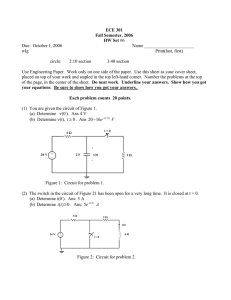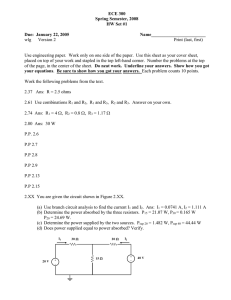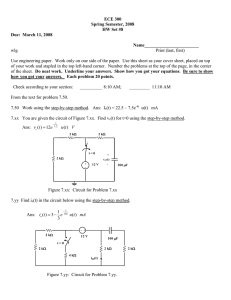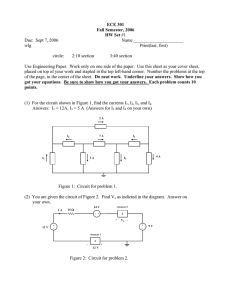Physics Problem Solving Challenge Questions & Answers
advertisement
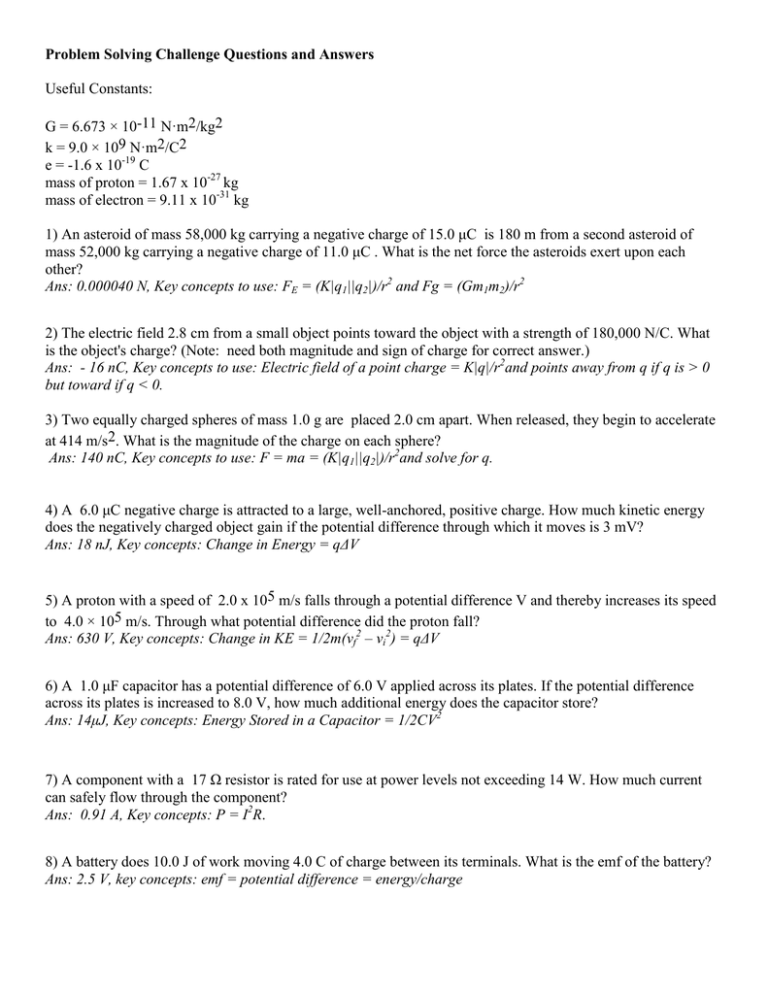
Problem Solving Challenge Questions and Answers Useful Constants: G = 6.673 × 10-11 N·m2/kg2 k = 9.0 × 109 N·m2/C2 e = -1.6 x 10-19 C mass of proton = 1.67 x 10-27 kg mass of electron = 9.11 x 10-31 kg 1) An asteroid of mass 58,000 kg carrying a negative charge of 15.0 μC is 180 m from a second asteroid of mass 52,000 kg carrying a negative charge of 11.0 μC . What is the net force the asteroids exert upon each other? Ans: 0.000040 N, Key concepts to use: FE = (K|q1||q2|)/r2 and Fg = (Gm1m2)/r2 2) The electric field 2.8 cm from a small object points toward the object with a strength of 180,000 N/C. What is the object's charge? (Note: need both magnitude and sign of charge for correct answer.) Ans: - 16 nC, Key concepts to use: Electric field of a point charge = K|q|/r2and points away from q if q is > 0 but toward if q < 0. 3) Two equally charged spheres of mass 1.0 g are placed 2.0 cm apart. When released, they begin to accelerate at 414 m/s2. What is the magnitude of the charge on each sphere? Ans: 140 nC, Key concepts to use: F = ma = (K|q1||q2|)/r2and solve for q. 4) A 6.0 μC negative charge is attracted to a large, well-anchored, positive charge. How much kinetic energy does the negatively charged object gain if the potential difference through which it moves is 3 mV? Ans: 18 nJ, Key concepts: Change in Energy = qΔV 5) A proton with a speed of 2.0 x 105 m/s falls through a potential difference V and thereby increases its speed to 4.0 × 105 m/s. Through what potential difference did the proton fall? Ans: 630 V, Key concepts: Change in KE = 1/2m(vf2 – vi2) = qΔV 6) A 1.0 μF capacitor has a potential difference of 6.0 V applied across its plates. If the potential difference across its plates is increased to 8.0 V, how much additional energy does the capacitor store? Ans: 14μJ, Key concepts: Energy Stored in a Capacitor = 1/2CV2 7) A component with a 17 Ω resistor is rated for use at power levels not exceeding 14 W. How much current can safely flow through the component? Ans: 0.91 A, Key concepts: P = I2R. 8) A battery does 10.0 J of work moving 4.0 C of charge between its terminals. What is the emf of the battery? Ans: 2.5 V, key concepts: emf = potential difference = energy/charge 9) A 5.0 V battery storing 43.0 kJ of energy supplies 1.5 A of current to a circuit. How much energy does the battery have left after powering the circuit for 1.0 h? Ans: 16 kJ, key concepts: P=IV, which gives how many Watts or Joules per second the circuit uses. From this, figure out how much energy the circuit uses in an hour and subtract from original energy storage. 10) Refer to the figure shown. What is the current through the 4.0 Ω resistor? Ans: 1.5 A. Key concepts: Use the loop rule on the left loop: 10V – 10i10=0, so i10 = 1A. Use the loop rule on the right loop: 16V – 4i4 -10i10 = 0, substituting in our value for i10, gives i4 = 1.5A 11) Each of the resistors in the circuit shown has a resistance of 160.0 Ω. What is the equivalent resistance of the circuit? Ans: 400.0 Ω, key concepts: In parallel: 1/Req = 1/R1 = 1/R2…. In series: Req = R1 + R2…. The two furthest right resistors are in parallel with each other. Their Req = 80 Ω. Once they are replaced by this Req, all of the resistors are in series with each other, so Req = 160 + 160 + 80 = 400 Ω. 12) Initially, for the circuit shown, the switch S is open and the capacitor is uncharged. The switch S is closed at time t = 0. In the figure shown, when the time t is equal to 8.0 s, the charge on the capacitor, in μC, is: Ans: 2300 μC. Key concepts: The equation for a charging capacitor is V = V0[1-e(-t/τ)], where V0 is the voltage across the battery and τ = RC. Solve for V and then use q = CV. 13) The resistors in the circuit shown each have a resistance of 600 Ω. What is the equivalent resistance of the circuit? Ans: 600 Ω. key concepts: In parallel: 1/Req = 1/R1 = 1/R2…. In series: Req = R1 + R2….The two top resistors are in parallel with each other, as are the two furthest to the right. Each of these two groupings has an equivalent resistance of 300. Once they have been replaced by their equivalent resistors, those two are in series with each other, giving a total resistance of 600 Ω.
